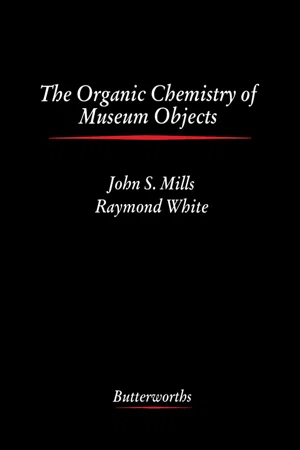
- 220 pages
- English
- PDF
- Available on iOS & Android
The Organic Chemistry of Museum Objects
About this book
The Organic Chemistry of Museum Objects provides an account of the composition, chemistry, and analysis of the organic materials which enter into the structures of objects in museum collections. This book is not intended to duplicate the information available in existing handbooks on the materials and techniques of art and conservation but rather to convey the state of knowledge of the chemical composition of such materials and so provide a framework for a general understanding of their properties. The book begins with a review of basic organic chemistry, covering hydrocarbons and compounds with functional groups. It then describes spectrometry and separation methods. This is followed by discussions of the chemistry and composition of oils and fats, natural waxes, bituminous materials, carbohydrates, proteins, and natural resins and lacquers. Subsequent chapters deal with synthetic materials, i.e., high molecular weight polymers of a wholly synthetic nature; and natural and synthetic dyestuffs. Also discussed are the deterioration and other changes in organic materials resulting from both free radical and ionic reactions; and the application of analytical methods to identify the organic materials of actual museum objects. This book is intended for both chemists and nonchemists.
Frequently asked questions
- Essential is ideal for learners and professionals who enjoy exploring a wide range of subjects. Access the Essential Library with 800,000+ trusted titles and best-sellers across business, personal growth, and the humanities. Includes unlimited reading time and Standard Read Aloud voice.
- Complete: Perfect for advanced learners and researchers needing full, unrestricted access. Unlock 1.4M+ books across hundreds of subjects, including academic and specialized titles. The Complete Plan also includes advanced features like Premium Read Aloud and Research Assistant.
Please note we cannot support devices running on iOS 13 and Android 7 or earlier. Learn more about using the app.
Information
Table of contents
- Front Cover
- The Organic Chemistry of Museum Objects
- Copyright Page
- Table of contents
- Preface
- Introduction
- Chapter 1. Basic organic chemistry
- Chapter 2. Analytical methods
- Chapter 3. Oils and fats
- Chapter 4. Natural waxes
- Chapter 5. Bituminous materials
- Chapter 6. Carbohydrates: sugars and polysaccharides
- Chapter 7. Proteins
- Chapter 8. Natural resins and lacquers
- Chapter 9. Synthetic materials
- Chapter 10. Dyestuffs and other coloured materials
- Chapter 11. Fundamental aspects of deterioration
- Chapter 12. Analysis in practice
- Index